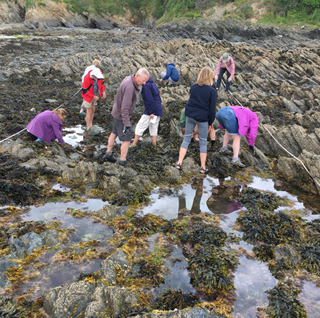 The Big Seaweed Search – a Wild Roseland / National Trust partnership event – took place earlier this summer. Chris Townsend reports on the findings.
The Big Seaweed Search – a Wild Roseland / National Trust partnership event – took place earlier this summer. Chris Townsend reports on the findings.
Our small group of marine conservationists enjoyed a fun day in mid-June with a seaweed workshop followed by a shore survey. This was the Roseland’s second Big Seaweed Search, an annual survey at Porthcurnick where we waded through deep pools and clambered precariously across rocks in a quest for 14 seaweed species.
Starting at the sea’s edge at low spring tide, we recorded nine target seaweeds as we walked up the shore along our permanent transect. Seaweeds grow in zones between high and low water, depending on whether they tolerate desiccation, or prefer long 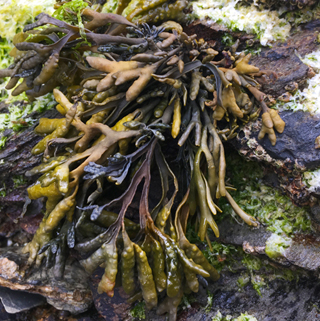 periods in water. Last year we found only two small clumps of Channelled Wrack (shown right) high on the shore, a plant exposed for 80% of the time and adapted for drying out, but not easy to spot. Finding it became a race and the eagle-eyed seaweeder won a bar of chocolate!
periods in water. Last year we found only two small clumps of Channelled Wrack (shown right) high on the shore, a plant exposed for 80% of the time and adapted for drying out, but not easy to spot. Finding it became a race and the eagle-eyed seaweeder won a bar of chocolate!
Wracks are tough, brown seaweeds which prefer cold water. Five were recorded, one less than last year – the Knotted Wrack we found was unattached, or ‘drift’, so not counted.
Two of four non-native plants, Wireweed (shown left) and Harpoon weed, were recorded as in 2017. Wireweed arrived in UK in 1970, probably imported from Japan on oysters.
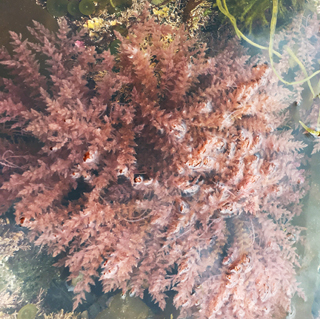
And, as before, the encrusting red seaweeds and coral weeds grew in all the rock pools. Rainbow wrack (shown below left) really captured our attention – not a project species but a spectacular iridescent seaweed which looks blue underwater.
The Big Seaweed Search is run by the Natural History Museum www.nhm.ac.uk/seaweeds and Marine Conservation Society. It enables people to learn about the seaweed flora of our shores (650 species), whilst contributing to scientific research. 14 indicators were selected because evidence shows these can be affected by environmental changes like sea surface temperature rise, ocean acidification and the spread of non-native species. The wracks and kelps are possibly affected by warming seas. Chalky red seaweeds become corroded by increasingly acidic water and the non-natives can become invasive, having an impact on local ecosystems.
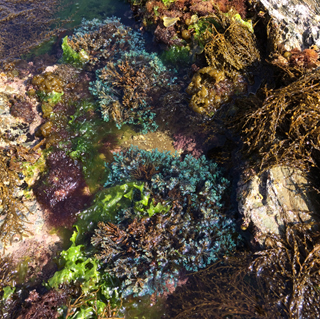 Our very sociable workshop gave an outline of the project and reasons why seaweeds are so important (e.g. kelp forests protect coastlines during storms and provide habitats for marine animals). Seaweeds, photographs, books, a microscope and hand lenses were available and the pressed seaweeds were particularly popular. We even had a game of Kelps and Wracks, each team trying to find their seven seaweeds before the others found theirs. Everyone was enthusiastic, good fun and brilliant at the ID. Hopefully we’ll have more events like this.
Our very sociable workshop gave an outline of the project and reasons why seaweeds are so important (e.g. kelp forests protect coastlines during storms and provide habitats for marine animals). Seaweeds, photographs, books, a microscope and hand lenses were available and the pressed seaweeds were particularly popular. We even had a game of Kelps and Wracks, each team trying to find their seven seaweeds before the others found theirs. Everyone was enthusiastic, good fun and brilliant at the ID. Hopefully we’ll have more events like this.
Look for local National Trust events at www.roselandonline.co.uk and Wild Roseland events at www.wildroseland.org and in respective facebook pages.
Upcoming Wild Roseland Walks and Talks – dates for your diary
Note that all events are free but a small donation of £3 would be welcomed.
BTO bird surveys in Cornwall
Thursday 20th September, 7.00pm, Philleigh Community Centre.
An evening presentation with Simon Taylor, Cornwall’s regional
representative for the British Trust for Ornithology. All welcome. Admission by donation.
Fungus Foray Walk
Saturday 29th September 2018, 10:00am, Sett Bridge, Ruan Lanihorne.
With Pauline Penna of the Cornwall Fungi Group. Contact David Hall on 01872 501429 or hallruan@aol.com to reserve a place.
Record your wildlife sightings!
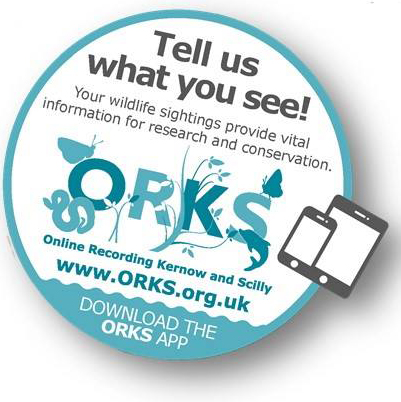 The Roseland area is under-recorded for its wildlife flora and fauna and we need more records. You can easily record single wildlife sightings in the Wildlife Trusts ORKS database online here. You can also complete an ORCS data form for multiple records here.
The Roseland area is under-recorded for its wildlife flora and fauna and we need more records. You can easily record single wildlife sightings in the Wildlife Trusts ORKS database online here. You can also complete an ORCS data form for multiple records here.
The ORKS recording app makes collecting and submitting wildlife sightings while you’re out exploring quick and easy, even without a mobile signal. The ORKS App is available for free download on iPhone and Android.
All data gets added to the National Biodiversity Network database, making it retrievable by anyone interested in doing research, locally, nationally or internationally.
Thank you for all the support you have given to Wild Roseland by attending our programme of talks, or in any other way.
Contributors:
Article and images by Christine Townsend.
Edited by Sarah Vandome.
Wild Roseland is a group of volunteers who care passionately about looking after the nature and landscape of the Roseland peninsula in south Cornwall. Through a number of initiatives and projects, the aim is to inspire and enhance the conservation of this special place for all.
References and links
Wild Roseland – http://www.wildroseland.org/
Enjoy more Roseland wildlife and landscapes – visit Sarah Vandome’s Heart of Roseland Facebook feature:
https://www.facebook.com/HeartOfRoseland?ref=hl
Wild Roseland is on Facebook.
